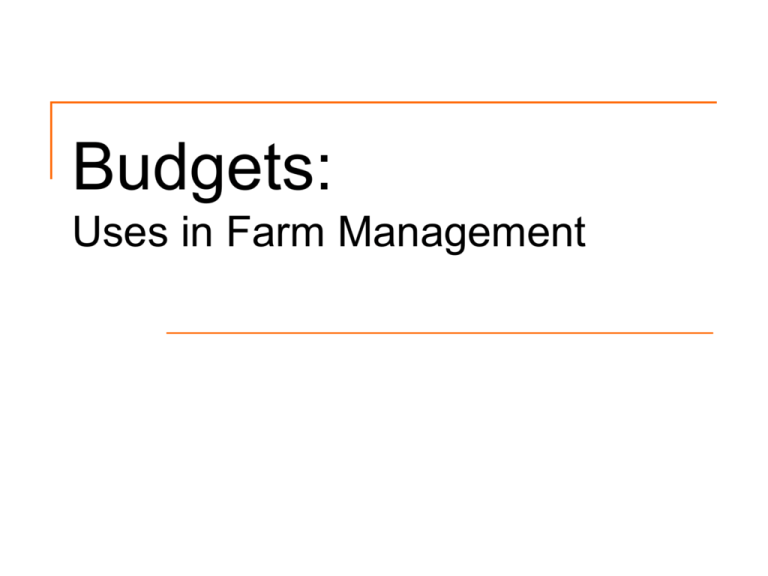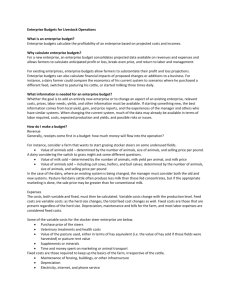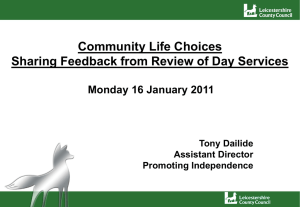Characteristics of Beef Industry Alliances
advertisement

Budgets: Uses in Farm Management Types of Budgets Whole-farm Enterprise Partial Whole-Farm Budget Identify the resources available for use in production Determine physical production data that will be used in the input/output process Identify reliable prices (input/output) Calculate expected costs and returns Provides a plan for maximizing the returns to owned resources. Enterprise Budgets Provide an estimate of potential revenue, expenses, and profit for a single enterprise Each type of crop or livestock is an enterprise The base unit for crops is usually one acre The base unit for livestock may be one head or some other convenient size Partial Budgets Focus on costs and benefits of alternative plans on a small part of the farm Consider only the costs and returns that will change Isolate the impact of change Organize data to minimize the chances of overlooking something or counting an item twice Why Budget? Why Budget? Planning Evaluate options before you commit resources Test economic and financial feasibility of alternatives (different enterprises, different production systems) Estimate profits Project cash flows Estimate the size of farm needed to earn a specified return Develop a production and marketing plan Uncover costs that you may not have considered Why Budget? Implementation Provide the documentation necessary to obtain/maintain creditworthiness Estimate the amount of rent that can be paid for land or machinery Identify production and financial risks and whether they may be managed Monitor cash flows Why Budget? Control Think of the enterprise budget as an enterprise specific “income statement” Compare projected to actual results Constructing an Enterprise Budget Revenue all cash and noncash revenue from production Operating or variable expenses all costs that would be incurred only if the crop/livestock is produced Ownership or fixed expenses costs that must be paid even if no crop/livestock is produced Profit return to all resources that were not charged in the budget (usually management) Revenue Crop Yield Price Government payments Crop insurance proceeds Changes in inventory Other sources Livestock Production: calves, pigs, milk, etc. Price Breeding herd replacements Changes in inventory (Operating) Variable Costs Crop Budget Seed, fertilizer, and chemicals Fuel, oil, and lubricants Repairs Labor (operator and hired) Interest on variable expenses Other cash expenses Livestock Budget Feed Veterinary and health Repairs Labor (operator and hired) Interest on variable expenses Fixed Costs Machinery, equipment, building/facility Depreciation Economic useful life Interest Average investment (opportunity cost on funds) Interest rate Taxes and insurance Land charge? Interpreting and Analyzing Enterprise Budgets An economic enterprise budget includes information on opportunity costs of labor, capital, land and perhaps management. The profit (or loss) is what remains after covering all expenses, including opportunity costs. Interpreting and Analyzing Enterprise Budgets Returns Above Total Operating Costs Production economically rational if total receipts minus total operating costs is greater than zero in the short run Returns Above All Specified Costs Return to management, risk, and land must be positive to survive in the long run Budget notes Many possible input levels and combinations. Least cost input combinations should be incorporated into budget. Fixed cost estimates are usually based on an assumed farm size or level of input use. Unit of measurement Time period Multiple products Other budget notes Price and production assumptions A budget to be used in next year’s plan should use an estimate of next year’s prices and production levels. A budget that is used to make long range plans should use long-run estimates of prices and production levels. Price received - ready markets or limited buyers? Use budgets to conduct sensitivity Average, best case, worse case yields or performance Average, best case, worse case prices Break-Even Analysis What quantity of yield/price is required to cover wheat production costs? Operating costs $157.73 Fixed costs 31.37 Total costs $189.10 To cover variable costs: $158 cost/33.4 bu = $4.72 break-even wheat price $158 cost/$6 wheat price = 26 bu break-even yield To cover all costs : $189 cost/33.4 bu = $5.66 break-even wheat price $189 cost/$6 wheat price = 32 bu break-even yield Sensitivity Analysis OSU Enterprise Budgets Crops Livestock Hay & Pasture Barley Cow/Calf Perennial Forages Canola Stocker Cattle Annual Forages Corn Meat Goats Alfalfa Corn Silage Stocker Goats Cotton Horticulture Grain Sorghum Blueberries Oats Grapes Peanuts Native & Improved Pecans Rye Peaches Soybeans Watermelon Wheat As a part of Annie’s Project, you can select any 4 budgets free! Summary: Enterprise Budgets Organize projected income and expenses for a single enterprise. Economic budgets will include opportunity costs in addition to cash costs and depreciation. Can be used to compare the profitability of different enterprises and are useful for developing a whole-farm plan. Need to know cost of production to Calculate break-even price Develop marketing goals Identify appropriate risk management strategies. Costs vary from farm to farm and year to year. Two steps in partial budgeting: Identify the impacts of change Quantify the impacts GIGO = garbage in, garbage out Partial Budget Format Positive Effect Additions to Income Added Receipts Reduced Expenses Total Additions Negative Effect Subtractions from Income Added Expenses Reduced Receipts Total Subtractions Net change associated with the decision = ? Should I harvest or graze-out wheat? Positive Effect Additions to Income Added Receipts Reduced Expenses Total Additions Negative Effect Subtractions from Income Added Expenses Reduced Receipts Total Subtractions Net change associated with the decision = ? Limitations of Partial Budgets Only useful in comparing the profitability of two alternatives Won’t tell you if a proposed change is the most efficient or profitable use of resources given all alternatives Doesn’t account for time value of money Data may not be readily available Some things are hard to quantify Sources of Budget Information Actual farm records Extension educators and specialists, educational materials, and meetings Books on husbandry, industry Producer organizations Other producers Internet sites Agecon.okstate.edu/budgets Budget Library in National Ag Risk Education Library: http://www.agrisk.umn.edu/Budgets/CustomSearch.aspx Use third party sources with caution! Budget Reminders Match to your operation List all relevant factors Be reasonable in your estimates Can be incomplete or unrealistic if adequate records not available Include cash and non-cash costs where appropriate Is it feasible? Cash flow vs. profit Actual vs. planned - compare at regular intervals to see if problems are occurring


